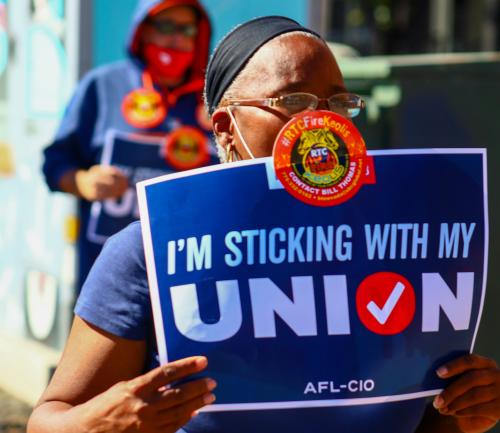- Revised Rule 452 may sharply affect shareholder participation
- Voter education campaigns starting to be established
- Client-directed voting contemplated as solution
- E-proxy delivery not optimal for some companies
- Wider proxy reform now on the policy agenda
This last year has been one of urgent, high-level debates about financial regulatory reform, but policy makers have also put more basic proxy plumbing issues on their agenda. Issuers, shareholder communications specialists and other market participants have forced this focus in part through their pronounced reaction to the SEC’s proposed rules on proxy access in more than 500 comment letters.
For their part, they seem finally to be succeeding with the message that piecemeal proxy reform is inadvisable and even unworkable. They welcomed SEC chairman Mary Schapiro’s acknowledgement this summer of ‘the long-smoldering concerns about the mechanics of the proxy voting process’, and her commitment to looking into them.
But even as the SEC has taken on this difficult project of examining the interlocking aspects of proxy voting, issuers and others throughout the proxy community are contending with a rule revision already on the books: the amended Rule 452, which eliminates the right of brokerage firms to vote uninstructed shares in uncontested director elections.
Issuers, and arguably retail shareholders themselves, have long expected brokers to vote those shares. Therefore, under the revised rule, which goes into effect next year, public companies are expecting to see steep declines in voter participation in their annual elections, which puts their director candidates at risk and even poses quorum issues.
For now, board directors, corporate secretaries and investor relations (IR) officers, and their advisers, are working hard to determine their vulnerabilities and ensure director nominees get the votes they need to acquire or retain seats. Plans of attack include voter education campaigns, allocation of more resources to proxy solicitation, rethinking e-proxy delivery, and explorations of innovations to capture retail voters’ preferences, such as client-directed voting.
‘Companies are going to have to be proactive,’ says Robert Ericson, a corporate partner in the New York office of Winston & Strawn. ‘It may be a real get-out-the-vote effort.’
Market participants are trying to assess the new landscape. In an October paper submitted to the SEC entitled ‘Practical solutions to improve the proxy voting system’, Kenneth Altman, president of proxy solicitation firm the Altman Group, outlined the scope of the impact of the revisions to Rule 452. Those that won’t feel much of an impact, he predicts, are large and mega-cap companies with high institutional ownership. The effects of the loss of the broker vote will, however, be more pronounced on smaller companies with lower institutional bases.
Smaller is riskier
The specifics of the voting structures mean generally that NASDAQ-listed companies are more vulnerable than NYSE-listed firms to losing large blocks of votes. Altman explains that the generally lower stock prices of NASDAQ companies tend to lead to higher levels of retail ownership and, in the past, to broker votes.
Further complicating the picture – particularly in the current downturn – is the prohibition on some institutions buying holdings in a company with shares priced under $5. Thus, a low-priced, small-cap company with a large retail base could see as much as 40 percent to 50 percent of its shares go unvoted in a 2010 annual general meeting.
Jeffrey Morgan, president and CEO of the National Investor Relations Institute (NIRI), is urging issuers to review, perhaps with their proxy soliciting firm, the voting results of prior shareholder meetings to determine the number of votes cast for directors by brokers using discretionary authority. Such efforts may have been rare in the past but won’t be in the wake of the Rule 452 revisions or in a proxy access era, Morgan explains. ‘Your proxy vote is no longer something you can take for granted,’ he warns.
Ted Wallace, director of research at the Altman Group, says he is seeing more client interest in the specifics of the shareholder base. ‘We’ve been very busy lately putting together impact analyses for our clients and then discussing the options and strategies for their 2010 annual meetings,’ he says. ‘We’ve also received many communications from law firms and company officers requesting more information about the amended Rule 452 and/or an impact analysis.’
In the future, Wallace says he believes this analysis will be a ‘must’ for issuers with majority voting provisions. ‘This amendment to NYSE Rule 452 opens a whole new can of worms, and some of these worms are pretty ugly,’ he says. ‘Negative recommendations from proxy advisory firms become a much more serious matter for issuers with a majority vote standard. ‘Just vote no’ campaigns by shareholder activists also have a much greater chance of success.’
New ways to talk
The corporate governance and proxy communities are thinking now about how to educate retail voters about the rule change, and even energize the electorate. Some companies are beginning to explore direct engagement with shareholders through alternative measures.
One notable first try is a blog by Johnson & Johnson’s senior counsel and assistant corporate secretary Doug Chia on JNJ BTW, the firm’s corporate blog. An explanation takes a bit of tutoring in the complexities of the proxy process, but Chia puts out a message in plain English to vote your shares. ‘Vote in line with Johnson & Johnson management’s recommendations or vote against them if that’s what you wish,’ he writes in the blog. ‘Just please take the time to vote, not only for our shareholder meetings, but for all of the companies in which you hold stock. We think it’s important that you do so. After all, voting in director elections is your legal right as a shareholder and, starting now, if you don’t, no one will do it for you.’
It is unclear how many shareholders follow the Johnson & Johnson corporate blog, so Chia says he is brainstorming internally about different ways to reach out to retail holders. ‘The blog is one way to reach a certain audience and to do it in a non-traditional format,’ he says. ‘I was really inspired by what John Seethoff at Microsoft started doing earlier this year on the ‘Microsoft on the issues’ blog.
‘I am actively encouraging my counterparts at other companies to start thinking outside the box and going beyond just using the proxy statement mailing and proxy solicitor calls as the sole methods of communicating with shareholders for voting purposes. The recent amendments to NYSE Rule 452 are forcing us all to do that, and it behooves us to start experimenting with new ideas now rather than after the proxy statement has been mailed if we have any hope of getting through to our target audience.’
Learning the rules
‘Education is something we will push,’ states Morgan. Though it is early days, he is working with the Shareholder Communications Coalition – comprising Business Roundtable, the National Association of Corporate Directors, NIRI, the Securities Transfer Association and the Society of Corporate Secretaries and Governance Professionals – to draft an education piece for SEC approval. Companies and brokers could link to it or use its language on their IR website.
Talks in progress with the SEC’s division of corporation finance have been very positive, though Morgan says ultimately the piece might come through the SEC’s office of investor education and advocacy. ‘We’re going down that road and trying to make it happen,’ he says.
While he supports issuers in their own education efforts, Morgan says he thinks there needs to be a message coming from a broad range of stakeholders so voters don’t interpret it as management’s agenda. Johnson & Johnson gets around this by exhorting shareholders to vote for management or against it, as long as they actually vote. ‘But there’s a challenge for companies that any time they start pushing a message on a proxy-type thing, it will be perceived poorly,’ Morgan says.
Lori Schock, the SEC’s director of investor education and advocacy, points out that the divisions of markets and trading, corporation finance and investor education are also thinking about how to get the word out to the retail community. Noting that the issue is complicated to explain, she comments: ‘Our simple message is: vote your shares. It’s a work in progress; it’s premature to get into strategy, but we are definitely working with all the stakeholders.’
Proxy solicitors are also getting in on the education act, and not just the education of shareholders but also of other major constituents in the voting process, by hosting webinars, writing articles and presenting to law firms and issuers via video conferences and in person.
Brokers are doing their part, too. ‘We usually generate a client communication on certain aspects of the proxy process around year-end by way of an insert included with clients’ year-end statements,’ says Paul Caviano, an executive director in the global wealth management operations of Morgan Stanley. ‘If we do the same this year we will likely include a general update on the rule change as a way to reinforce the central point that your vote is important.’
The path forward
The get-out-the-vote effort may come down to old-fashioned canvassing. ‘When it comes to an actual solicitation, we have many strategies to help maximize the vote response and mitigate the impact of the loss of the broker vote in director elections,’ Wallace says. ‘I say ‘mitigate’ because there really isn’t going to be any way to bring the director vote back to pre-2010 levels.’
Brokers are considering the viability of client-directed voting (CDV), an idea first put forward by Stephen Norman, the former corporate governance officer and corporate secretary of American Express. This effort would broadly capture retail shareholders’ set of preferences on corporate governance and strategy at account inception, then later cast votes accordingly, with an opportunity to review prior to each annual meeting.
‘Implementation of CDV is possible, though it would take a degree of effort and expense,’ Caviano says. ‘We are engaged with the various constituents in the proxy process through a number of forums. Should these stakeholders reach consensus that CDV is an important capability and gain regulatory endorsement, the industry could move forward accordingly.’
Amy Goodman, a partner with Gibson Dunn & Crutcher, says she thinks CDV is feasible, but ‘will require cooperation with the SEC’. Morgan can also see its virtues, but has concerns. Most challenging would be surveying investors, given the range of possible proxy issues, he feels. ‘CDV is one of those pieces that fits into the overall discussion of improving shareholder communications but I’ve not yet seen a good model to really evaluate it,’ he says.
Little fixes
The players do, however, have advice about the small steps issuers can take for the annual meeting next season. ‘Make sure you have a routine item on your proxy so the broker vote can get you a quorum,’ Morgan says. Others are also urging reconsideration of notice and access as a method for delivering the proxy statement in an amended Rule 452 environment, given the retail shareholder voter boost that can be achieved through hard-copy delivery.
In a related development, the SEC is looking into ways to improve the messaging around e-proxy notices so that shareholders don’t miss the point. To this end, the regulator in October began soliciting comments on steps to address the steep decline in response rates resulting from the implementation of notice and access.
In his ‘Practical solutions’ proposal, Altman similarly notes dissatisfaction with Broadridge’s voting instruction form, which he says is ‘confusing’ and does not feel as if it has come from the actual corporate issuer. He would like to see greater customization and the response rates achieved by transfer agents of their mailings to registered shareholders.
Altman is also floating an ‘all beneficial owners’ concept to counterbalance the revisions to NYSE Rule 452, which he first put forward in 2006. Such a measure would involve eliminating the distinction between non-objecting beneficial owners and objecting beneficial owners, at least as far as record dates for annual and special meetings are concerned. The measure would permit issuers to gain access to shareowner names so that they could communicate directly on a limited set of corporate actions.
‘Ultimately, it isn’t enough for a corporation to know that its directors need the support of the retail holders,’ Wallace says. ‘The corporation also needs to know how to get in contact with its shareholders to ask for their support.’
Rule 452: Routine vs non-routine proposals
Examples of routine proposals
- Value-added uncontested director elections (expires January 1, 2010)
- Ratification of auditors
- Stock splits
- Increase in authorized common stock (not tied to mergers)
Examples of non-routine proposals
- Approve/amend a stock plan
- Increase authorized preferred stock
- Approval of merger or reincorporation
- Shareholder-sponsored proposal (limited exceptions)
- Late mailing
Source: The Altman Group
Rule 452 impact analysis
Issuers with sizable retail holdings will need to analyze the impact of this change well in advance of their annual meetings and have a plan in place to ensure a successful director
reelection process.
Case Studies
Company A: 81 percent institutionally owned
Percentage of FOR votes lost
- Traditional mailing - 10.3 percent
- Notice and access - 13.8 percent
Company B: 65 percent institutionally owned
Percentage of FOR votes lost
- Traditional mailing - 20.1 percent
- Notice and access - 24.9 percent
Company C: 41 percent institutionally owned
Percentage of FOR votes lost
- Traditional mailing - 35.5 percent
- Notice and access - 44.0 percent
Source: The Altman Group








